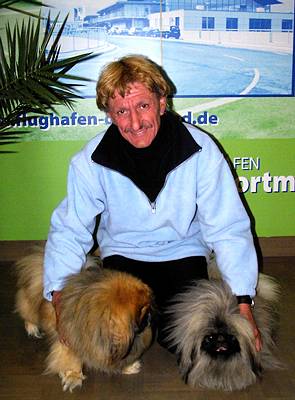|
<< -- 3 -- Tess Crebbin CANINE CHOREOGRAPHY

Depending on their size, dogs can prefer faster or slower tempi. 'In general,' Lind explains, 'the rule of thumb is that they do not like the really slow tempi. Even an adagio is very difficult for a dog, andante as well. We try to work somewhere around the 146-152 beat range. Also, it is interesting that smaller dogs like their music faster than bigger dogs, which is directly related to their speed of walking. When I teach rhythm to a dog, I work with voice signals, not hand signals. It would be impossible for me to use hand signals, as in dancing there are so many different moves involving the hands and this could get very confusing for a dog. I use the letter T for left, the letter P for right, and further, all words indicating a move to the left contain the vowel I, whereas all words indicating a move to the right contain the vowel E. This, of course, means that I cannot then use the word "sit" to ask the dog to sit down, so we use the word "squat" instead.'
In his show, each dog works with one dancer whose movements he closely follows and synchronizes with. To illustrate how playfulness enters into his choreography, Professor Lind explains: 'When a dog is to lie down, a simple command of "lie down" is being replaced by the figure of "lurking" -- the dog still lies down, but "lurks" as he watches the movement of his dancer. That way, the show turns into an exercise of fun for the dog.'
The Lind-art company is enormously successful and travels all over the continent, sometimes up to 1000km at a time. 'This means that we can only get together to practice, as a team, about four or five times a year. In the interim, the dogs and their humans have to work alone and we rely a lot on the internet to communicate with each other and to work out the various moves.
Currently, the company is preparing the choreography of 'Summer' from Vivaldi's Seasons.
'With dogs, we have to keep in mind that they cannot focus their attention as long as humans, so we work on short segments rather than one long one. The entire Seasons would be too much for them in one go, for instance,' Lind explains.

Love of music and dogs: Professor Ekard Lind with two exhibitors at the 2005 Dortmund International Dog Show. Photo © Philip Crebbin
|
Asked what else is on the classical program for his dogs, Lind muses: 'Cello music is something else that is of great interest, so something like the Bach Cello Suites are also under consideration for the near future.'
More information about the unusual and inspiring canine choreography of Ekard Lind can be found on the website www.ekard-lind.at.
|

